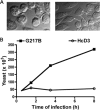Changes in membrane fluid state and heat shock response cause attenuation of virulence
- PMID: 20139193
- PMCID: PMC2838053
- DOI: 10.1128/JB.00990-09
Changes in membrane fluid state and heat shock response cause attenuation of virulence
Abstract
So far attenuation of pathogens has been mainly obtained by chemical or heat treatment of microbial pathogens. Recently, live attenuated strains have been produced by genetic modification. We have previously demonstrated that in several prokaryotes as well as in yeasts and mammalian cells the heat shock response is controlled by the membrane physical state (MPS). We have also shown that in Salmonella enterica serovar Typhimurium LT2 (Salmonella Typhimurium) overexpression of a Delta(12)-desaturase gene alters the MPS, inducing a sharp impairment of transcription of major heat shock genes and failure of the pathogen to grow inside macrophage (MPhi) (A. Porta et al., J. Bacteriol. 192:1988-1998, 2010). Here, we show that overexpression of a homologous Delta(9)-desaturase sequence in the highly virulent G217B strain of the human fungal pathogen Histoplasma capsulatum causes loss of its ability to survive and persist within murine MPhi along with the impairment of the heat shock response. When the attenuated strain of H. capsulatum was injected in a mouse model of infection, it did not cause disease. Further, treated mice were protected when challenged with the virulent fungal parental strain. Attenuation of virulence in MPhi of two evolutionarily distant pathogens was obtained by genetic modification of the MPS, suggesting that this is a new method that may be used to produce attenuation or loss of virulence in both other intracellular prokaryotic and eukaryotic pathogens. This new procedure to generate attenuated forms of pathogens may be used eventually to produce a novel class of vaccines based on the genetic manipulation of a pathogen's membrane fluid state and stress response.
Figures




References
-
- Acharya, P., R. Kumar, and U. Tatu. 2007. Chaperoning a cellular upheaval in malaria: heat shock proteins in Plasmodium falciparum. Mol. Biochem. Parasitol. 153:85-94. - PubMed
-
- Balogh, G., I. Horvath, E. Nagy, Z. Hoyk, O. Bensaude, and L. Vigh. 2005. The hyperfluidization of mammalian cell membranes acts as a signal to initiate the heat shock protein response. FEBS J. 272:6077-6086. - PubMed
-
- Cheminaya, C., and M. Hensel. 2008. Rational design of Salmonella recombinant vaccines. Int. J. Med. Microbiol. 298:87-98. - PubMed
Publication types
MeSH terms
LinkOut - more resources
Full Text Sources
Medical

